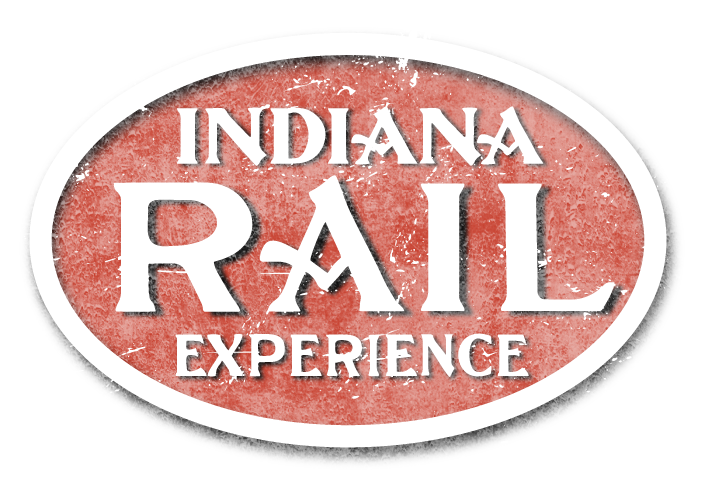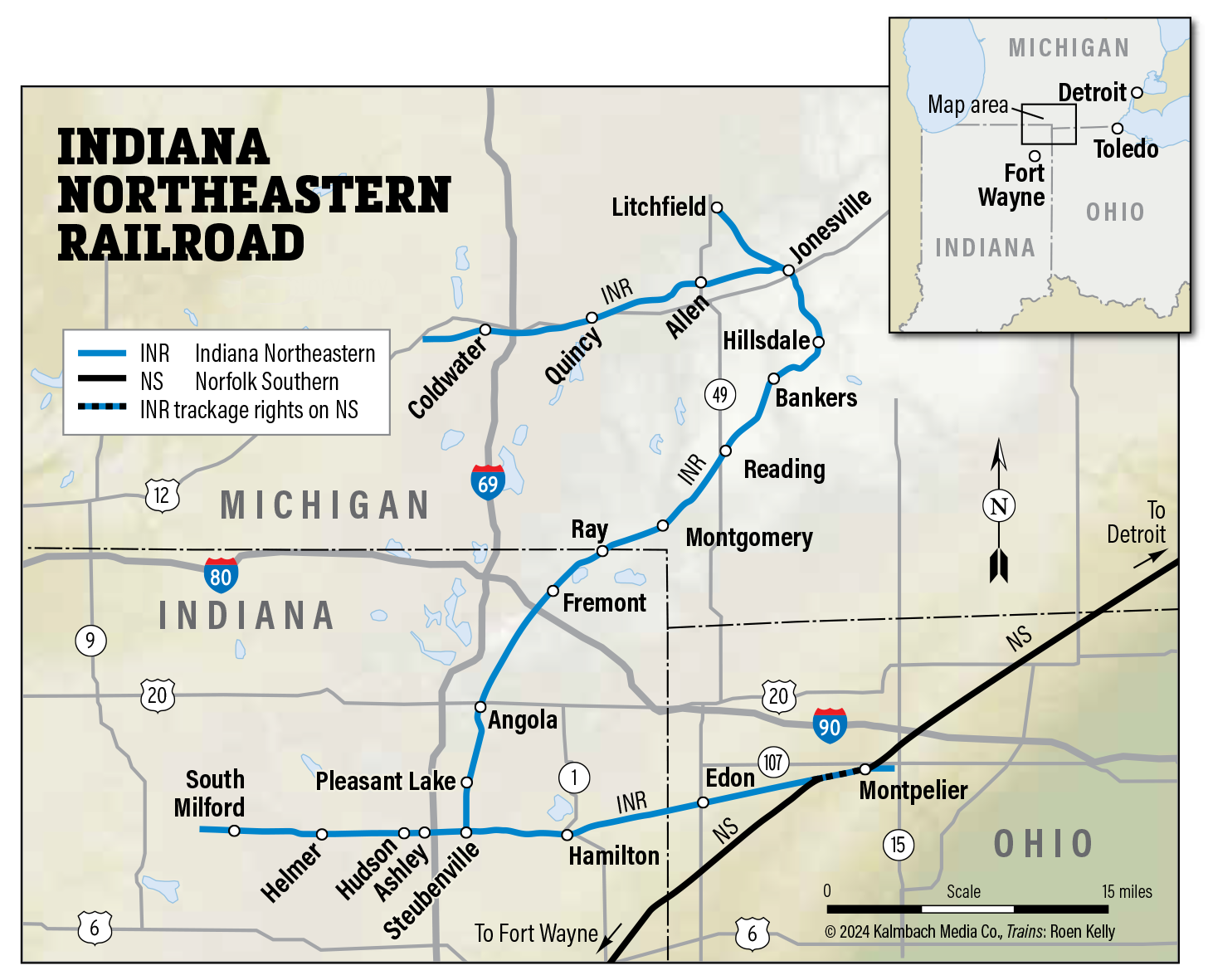THE NEW YORK CENTRAL ROUTE
Steubenville, Indiana
At the southernmost point in Steuben County lies Steubenville, where the former Fort Wayne & Jackson Railroad—chartered in 1872—crossed the Wabash’s Fourth District at grade. Once part of the mighty New York Central System, this line endured the trials of mergers and abandonments in the latter half of the 20th century, passing through the hands of Penn Central and Conrail before its southern end was removed. Today, from Steubenville north to Hillsdale, Michigan, the line remains in service under the stewardship of the Indiana Northeastern Railroad.
Hillsdale, Michigan
Hillsdale is where the FW&J intersects the historic “Old Road,” so named as it was the earliest route by rail to reach Chicago from the east. Later eclipsed by the Lake Shore & Michigan Southern’s more direct “Air Line,” the Old Road endures under Indiana Northeastern operation as far west as Coldwater.
Pleasant Lake, Indiana
A quiet hamlet nestled among northern Indiana’s lakes, Pleasant Lake was once a bustling resort community. It boasted an ice house that harvested from the lake itself, gravel pits that dispatched countless carloads, and yards for lumber, brick, and livestock. The town’s 1882 Lake Shore & Michigan Southern depot still stands in splendid form, listed on the National Register of Historic Places. Across the tracks, visitors may observe the stout foundations of a former water tank—once essential to the age of steam. The line also spans the charming Pigeon Creek, linking to Long Lake and eventually to Mongo, Indiana.
Angola, Indiana
Founded in 1838 and named for Angola, New York, this lively town is known as the home of Trine University, originally Tri-State Normal College. The city square features a striking Civil War monument listing the names of 1,278 Union soldiers from the area. The stately courthouse, dating to 1868, is crowned by a weathervane—not of a rooster, but of a fish, befitting the county’s boast of “101 lakes.”
Nearby Pokagon State Park is a regional jewel, complete with a refrigerated toboggan slide and the grand Potawatomi Inn. The St. Joe Valley Interurban once entered town from the northwest, crossing beneath the FW&J near modern-day State Road 127.
Fremont, Indiana
First known as Willow Prairie, later as Brockville, and finally Fremont in 1848, this town rests on the old Vistula Trail (now SR 120). The railroad continues to serve local industry here, including a plastics works and a commercial bakery.
Ray, Indiana/Michigan Line
Straddling the state line, the hamlet of Ray once enjoyed its own post office, numerous stores, a mill, and a schoolhouse. Established in 1872, it remains a scenic and photogenic highlight for passengers aboard steam excursions.
Montgomery, Michigan
Once whimsically known as “Frog Eye,” Montgomery was laid out at the coming of the railroad and was to serve as a junction for the uncompleted Mansfield & Coldwater Railroad. The roadbed for this never-built line remains visible on the west edge of town.
Reading, Michigan
Originally called “Basswood Corners,” Reading (pronounced REED-ing) hosts Indiana Northeastern’s largest agricultural shipper: The Andersons Trade Group. From here, thousands of carloads of corn and soybeans begin their journey each year.
Bankers, Michigan
Once a vital junction, Bankers marked the divergence between the original FW&J route to Jonesville and the Detroit, Hillsdale & Southwestern. The latter was eventually absorbed by the LS&MS to connect to Hillsdale. The line east of Hillsdale was known in timetables as the Ypsilanti Branch.
Hillsdale, Michigan
A place of historical and industrial distinction, Hillsdale is the seat of Hillsdale County and home to Hillsdale College, founded in 1844. The Michigan Southern Railroad reached the town that same year, though it was 1852 before rails stretched westward to Chicago. Once headquarters of the New York Central’s Lansing Division, Hillsdale featured a roundhouse, yard, and saw 16 daily passenger trains. Several original structures remain—including the station, division headquarters, and freight house—the latter now slated for revitalization.
In 2022, steam made a triumphant return when Nickel Plate Road no. 765 visited Hillsdale—the largest locomotive to do so since steam gave way to diesel decades ago.
Jonesville, Michigan
Jonesville marks another important crossroad of the Central’s Michigan operations. Its historic depot, over 140 years old, has found new life as a bed and breakfast.
Quincy, Michigan
Settled in 1830 and named for Quincy, Massachusetts, this town blossomed along the famed Sauk Trail—later the Chicago Road. Today, it serves as the turnaround point for the Little River Railroad, whose vintage trains delight passengers with picnic stops in a local park.
Coldwater, Michigan
Originally called Masonville, Coldwater now serves as headquarters for the Little River Railroad, whose vintage steam locomotives and coaches depart from a preserved Lake Shore depot. Coldwater and Hillsdale bracket the Michigan territory of the Indiana Northeastern, though fragments of the old New York Central remain in places like Adrian and White Pigeon—alas, no longer accessible by rail.
THE WABASH ROUTE
Pergo, Ohio
The Wabash’s Fourth District begins just west of Montpelier, Ohio at a junction known as Pergo. Once part of a bustling through-route to Chicago, only 37.5 miles remain in service, now operated by the Indiana Northeastern. The railroad interchanges with Norfolk Southern in Montpelier, connecting with the broader rail network.
Edon, Ohio
Tracks were laid through Edon in 1893, just in time to carry travelers to the World’s Columbian Exposition in Chicago. The Wabash depot was relocated several times but is now preserved in a public park. Edon remains an agricultural stronghold, with a cooperative elevator and fertilizer plant dispatching hundreds of loads annually.
Hamilton, Indiana
Nestled on the Steuben-DeKalb County line, Hamilton flourished after its modest mill pond was transformed into a lakefront retreat. Two passing tracks remain here, useful for sorting trains and exchanging freight blocks.
Ashley, Indiana
Founded as a “company town” in 1892 and named for Wabash president O.D. Ashley, this location was the original division point of the Wabash route between Detroit and Chicago. Though those facilities moved to Montpelier in 1907, Ashley remains active with five local customers served by the Indiana Northeastern.
Hudson, Indiana
Neighboring Ashley, this quiet farming town is home to the railroad’s locomotive shop and maintenance facility. Here, mechanics conduct everything from routine inspections to full overhauls of motive power.
Helmer, Indiana
Helmer features a long passing siding and was once the starting point for a Wabash branch to Stroh, constructed to serve a cement plant there.
South Milford, Indiana
This unincorporated village is home to South Milford Grain, a vital shipper on the line. While the tracks end two miles west of the elevator, the facility continues to dispatch thousands of carloads of corn, soybeans, and wheat each year.

